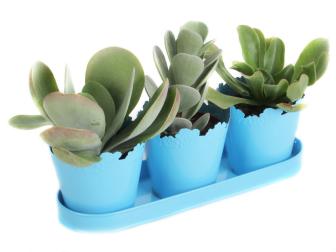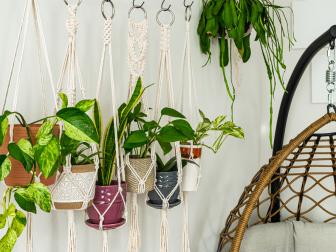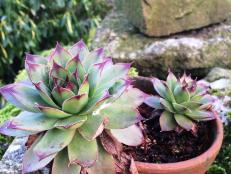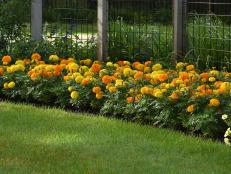How to Propagate Plants
Propagating plants is easy. Plus, learning how to propagate plants can save you money you'd otherwise spend on buying new plants.
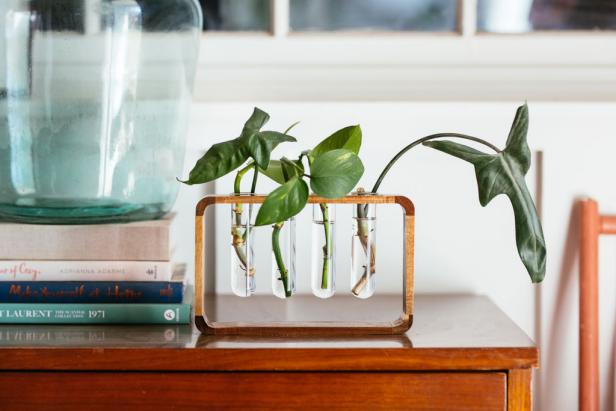
Jennie Andrews
Learning how to propagate plants can be a rewarding and money-saving way to add plants to your home.

Sometimes referred to as "plant cloning," plant propagation allows you to create new plants from a single plant parent without the need for pollination. Some plants are better at being cloned than others, but many indoor plants are good candidates. Learning how to propagate plants can save you money, helping you create a larger indoor (or outdoor) plant family with little expense. It’s also fun.
The three most common propagation methods (and the most useful ones for the home gardener) are with cuttings, layering and by dividing. The best method to use depends on the type of plant. We’ll talk you through the three main techniques and give advice for plants commonly propagated by these methods, including succulents (cuttings), blackberries (layering) and dahlias (dividing), as well as tips on propagation tools and materials.
Why Propagate Plants?
There are many good reasons to clone your plants. Here are a few.
- Propagating helps you grow new houseplants and succulents that are difficult to start from seed.
- It gives new plants a head start, as opposed to growing from seed. The offspring of a successful cloning is already semimature, which means you avoid the long wait and potential complications that come with growing a plant from seed.
- Every cloned plant is a plant you don't have to buy, so learning how to propagate can save a lot of money.
- Propagating forms an exact match of the parent because you are cloning genetic material. On the other hand, a plant grown from seed, particularly a hybrid, may not be an exact replica of the parent plant; for example, a dahlia flower grown from seed may be a totally different color or petal structure from the parent.
How to Propagate Plants From Cuttings
Try the simplest and most common type of plant propagation: cuttings. This method is also the safest for the parent plant. Virtually any type of plant can be propagated with cuttings. Success depends on taking the best type of cutting for the plant.
Cutting types include:
- Leaf cuttings (where only the leaf and petiole of the plant is cut, including pothos, peperomia, African violet, Rex begonia, kalanchoe, and other succulents and houseplants)
- Softwood stem cuttings (often used for hydrangeas and roses or even herbs and vegetables like basil and tomatoes)
- Hardwood stem cuttings (for fruit trees and other deciduous plants).
Depending on the type of plant, cuttings can be grown in water, soil or even air. Many leaf cuttings can be started in water and then transplanted to soil after roots develop, though succulents are best started in soil. Softwood and hardwood cuttings typically need to be started in soil, though tomatoes can be started in water and moved to soil. It depends on the plant.
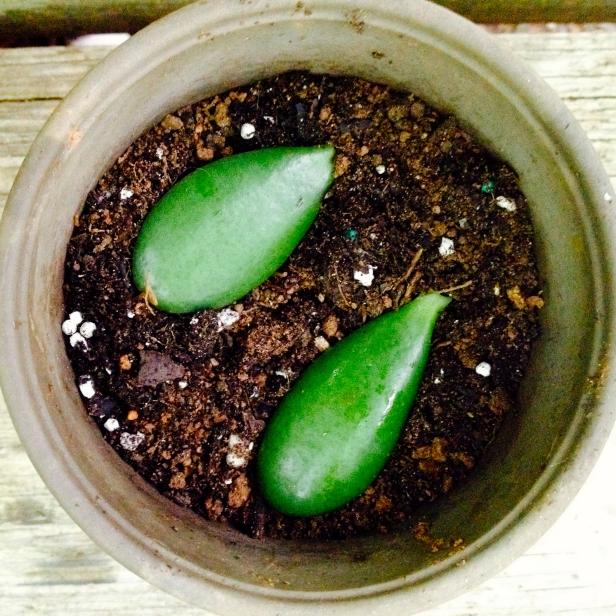
Photo by Lynn Coulter
Succulents can be easily propagated from cuttings. Be sure to start with a disease-free and well-hydrated plant. From How to Propagate Succulents.
While propagation can be done in any season, the cooler the weather, the slower the growth will be, so it’s typically best to take cuttings during the plant's active or growing season, as warmth helps with root formation. The exception is hardwood cuttings, which are taken in the plant’s dormant season, typically late fall or winter.
How to Grow Plants From Cuttings:
- Using a very sharp, sterilized blade, remove a small section of the plant. (Use a straight blade, not serrated.) For a pothos, each cutting should have about three nodes (the bumps where the leaves form). Gently pinch the bottom leaves from the stem, leaving at least 1-2 leaves at the top.
- If propagating directly into soil, apply a rooting hormone. Dip the cut end into water and then into rooting powder or gel. Bury that end directly into nutrient-rich potting soil and keep the soil damp until roots and/or new growth on the cutting have formed.
- If propagating in water, skip the rooting hormone. Simply place the cutting into water and watch for roots to form. Roots should be approximately 2-3 inches long before planting into soil. While not absolutely necessary, a hydroponic system can speed the formation of roots by adding oxygen to the water being used in the process.
How to Propagate Succulents
Don't buy another plant—creating new succulents from existing leaves couldn't be easier.
How to Propagate Succulents:
- Using a very sharp, sterilized blade, slice leaves from the plant. The sliced edge will be damp.
- Lay the leaves on a plate out of direct light but in a dry, slightly warm location for a day or so. Watch for the sliced end to dry and form a callus.
- Once a callus has formed, dip the end into a rooting hormone and lay on top of slightly damp potting soil for cactus and succulents. Continue to keep in a warm spot out of direct light. A baby succulent will begin to form on the end of the leaf. As it forms roots, the parent leaf will wither and die. Once the roots are well-formed, plant in the soil.
How to Propagate by Layering
While propagation by cutting requires removing a part of the parent plant, layering promotes growth of a clone directly attached to the parent plant; the new plant is only removed from the parent once roots have formed. Simple layering, tip layering and air layering are the three methods of propagation by layering.
Propagation by Simple Layering
Vining perennials and plants with low branches, including climbing roses, forsythia, boxwood, hydrangeas and azaleas, are good candidates for simple layering. Here’s how to clone plants by simple layering.

Lynn Coulter
While propagating by cutting requires removing a part of the parent plant, layering promotes growth of a clone directly from the parent plant. From How to Propagate Hydrangeas.
- In either very early spring or very late summer, identify a strong, healthy branch close to the ground or already touching the ground.
- Where the branch will touch the ground on the underside of the stem, use a sharp, sterilized blade to scrape away a 1-inch section of the hard, green outer layer of the stem, showing the white cambium layer. This creates a wound that will grow roots.
- Paint the exposed cambium with cloning hormone gel. Some plants will grow without the hormone but using it will speed up the process.
- Dig a shallow trench adjacent to the parent plant at the spot where the low branch would naturally touch the ground. Bend the stem so that the injured section rests inside that trench and the tip is above ground. Cover well with nutrient-rich soil.
- Keep well-watered until roots and/or new growth begin to form. When new growth is visible, use a sharp blade to sever the clone from the parent plant.
- For best results, leave the cloned plant in place for a year before transferring to a new location.
How to Propagate Hydrangeas
Use cuttings or an easy ground layering method to grow more gorgeous shrubs for your garden.
Propagation by Tip Layering
Blackberries and raspberries can be propagated by tip layering. Tip layering follows nearly identical steps to simple layering, but instead of burying a stem so that the tip emerges from the soil, the actual tip of the stem is buried. The buried tip will eventually form roots and push growth up through the soil.
Propagation by Air Layering
Air layering encourages growth of a new plant while attached to an existing plant, like the other forms of layering. However, in air layering the growth happens above ground. This method is useful for plants with stronger, less flexible stems, like bush roses, fig trees, magnolia and holly.
Air layering is on the expert-level side of propagation techniques; we’re not including full instructions, but here are some basics. It starts with a cut on a stem a few inches from the branch tip. The cut is propped open with something like a toothpick, then surrounded with sphagnum moss or a similar medium and wrapped to retain moisture and protect from light. Roots will form from the cut. After enough roots have formed, they can be cut away from the parent and planted in soil.
Propagating by Dividing
Instead of traditional roots, some plants produce bulbs, tubers or rhizomes. These root systems can be divided from one large plant into several independent plants.
Plants that can be cloned using division include dahlias, irises, violets, all types of lilies and many others. Plants that form root clumps such as pothos and snake plants can also be divided.
The easiest way to identify if a plant can be cloned through division is to identify whether the plant has multiple stems or a single stem. If the plant has multiple stems growing directly from the ground, chances are division is possible. Each section of a divided plant needs to contain all the parts of that plant: root (including tubers, bulbs or rhizomes), stem and leaf.
How to Hang Plants from the Ceiling
Learn the correct steps to securely and safely hang plants from the ceiling.
Dividing plants sometimes becomes necessary for plants that have outgrown their growing space; it can improve the health of crowded plants. For example, dahlias need to be divided every couple of years to maintain healthy plants.
How to Propagate Dahlias and Other Tubers:
- In the late fall (before the first frost) or very early spring, dig up the tuber clump, being cautious to keep the entire tuber. Identify the main stem and individual tubers. For a tuber to be viable, it needs to be able to grow its own stem and leaves, so you will want to look for "eyes" or nodes at the top of each tuber. The eyes look like very small warts. This node is where the new stem and leaves will grow.
- Use a very sharp, sterilized blade to slice off tubers above the eyes as close to the main stem as possible.
- Replant the parent plant and plant the separated tubers with the eye up in nutrient-dense soil. Tubers are very susceptible to rot, so do not heavily water tubers until new growth is visible.
Plants grown from bulbs, rhizomes or root clumps are even easier to divide. These include irises and hellebores. After digging up the entire plant, use a spade and/or hands to gently separate into sections that include root (or bulb/rhizome), some stem and leaves, and replant.
Tips on Propagating Plants
No matter what kind of propagation you try, a few tips and tricks will go a long way to success.
- Be sure to start with a disease-free and well-hydrated parent plant. This is true for any propagation method, but especially cuttings. Water your plant well the day before taking cuttings and only choose healthy leaves and stems.
- Always use clean tools to divide plants. You can sterilize any garden tool (including snippers and spades) by soaking them in isopropyl alcohol with a concentration of at least 70 percent.
- Cuttings love a humid environment and bright, indirect light. When propagating indoors, choose a brightly lit area away from drafts and vents. To hold in moisture and create a mini greenhouse, try covering the cutting with a recycled clear plastic container or bag. For the perfect propagation environment, consider a grow light.
- Know when to use rooting hormone. As a general rule, cuttings started in water do not need rooting hormone. The powder washes off quickly and does little good. Cuttings started in peat or soil, however, typically benefit from rooting hormone powder or gel.
- When cloning in water, clean water leads to healthy roots. Start with distilled water and then watch for the water to become murky. Cloudy water can signify unwanted bacteria growth, so empty and clean the container and refill with fresh water. Otherwise, simply be sure to top off the water every few days so the plant nodes stay fully submerged.
- Once healthy roots have formed, transfer the new plant to its new home. The longer the plant remains out of the soil or attached to the mother plant, the more difficult it will be to viably transplant into new soil.






